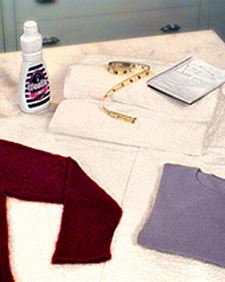You gotta hate 'em. They're so annoying - especially when you discover one in your favorite sweater just as you left the house. Well, there's some hope. But first, let's try to figure out how it got there in the 1st place.
1) It was made by the larva of a moth - not the actually moth.
2) The larva don't really crave cashmere (or wool, angora, silk, alpaca, or camel hair for that matter). What they do want is what we humans leave behind - sweat, skin flakes, food crusties, some makeup... sorry to be so gross.
3) The larva also prefer the dark and don't really want to be disturbed (by movement, air flow, etc.)
So, say you wore that favorite sweater out to dinner last night - to a fancy restaurant so you put on makeup, perfume, hairspray - you know, got all dolled up. At dinner you dripped a little sauce from your Boeuf Bourgogne - you dabbed it up right away so it didn't stain. Then, after dancing until 1am (rmember this was a fancy dinner and your date was hot!), you got home, folded up your sweater carefully & neatly (it's expensive afterall) and put it back on the shelf in the back of the closet. Fast forward to the company Christmas party (not the black tie one, the less formal office get together), and you get out your cashmere again. Again, you get all dolled up (see above), throw on your coat (because you are running late), hop in a cab, and rush to the bar where everyone has already arrived. As you struggle taking off your coat, you look down and notice that pesty little moth hole, right at belly button level. And everyone is staring at it, since your skin is porcelain white underneath. Why you? What did you do to desserve this?
Let's review in reverse order, just for excitement:
1) You stored your sweater in a dark area that gets virtually no attention (or airflow).
2) You sweated in your sweater and didn't wash or dry clean it to get the sweat out.
3) You spillt food on it (and didn't wash or dry clean it).
4) You got makeup, perfume and hairspray on it (and didn't wash or dry clean it)
What's the lesson here? Only store CLEAN cashmere in an area that gets light and air. (like an open shelf). Can holes be fixed? Often times yes. Will you get more holes? Sometimes. Do you have to throw your sweater away? No, if you are too embarrassed to wear something with a mended hole in it, have a scarf made out of it!
That said - I will offer a special deal to those who took the time to read to the bottom of this very long post. Mail me your old cashmere sweater (assuming that it doesn't look like swiss cheese), and get $5 off a scarf + free 1st class shipping. You can email me through my
etsy shop (the "contact hautegoat" link is on the right).




